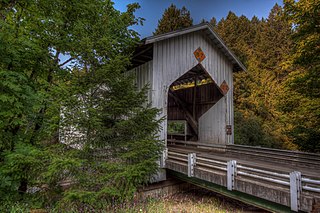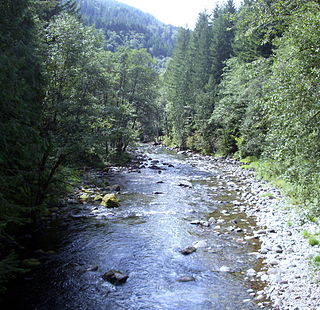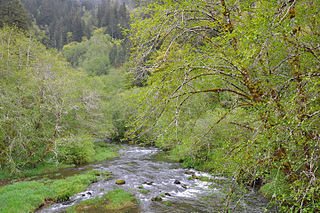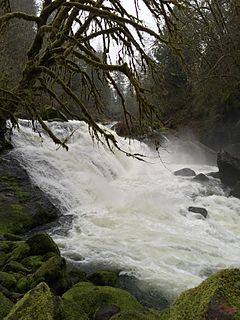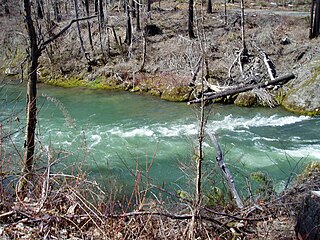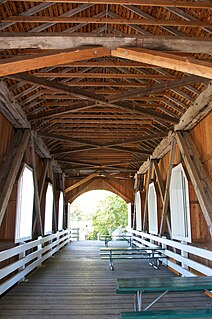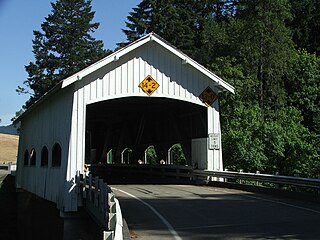| Cavitt Creek | |
|---|---|
 | |
| Etymology | For Robert L. Cavitt, who settled along the creek in the mid-19th century [1] |
| Location | |
| Country | United States |
| State | Oregon |
| Region | Umpqua National Forest |
| County | Douglas |
| Physical characteristics | |
| Source | Cascade Range |
| - location | near Red Butte |
| - coordinates | 43°08′43″N122°52′18″W / 43.14528°N 122.87167°W |
| - elevation | 4,019 ft (1,225 m) [2] |
| Mouth | Little River |
| - location | near Peel |
| - coordinates | 43°14′27″N123°01′14″W / 43.24083°N 123.02056°W Coordinates: 43°14′27″N123°01′14″W / 43.24083°N 123.02056°W [3] |
| - elevation | 889 ft (271 m) [3] |
Cavitt Creek is a tributary of the Little River in Douglas County in the U.S. state of Oregon. [4] From its source near Red Butte, the creek flows generally west then north through the Umpqua National Forest of the Cascade Range before entering the river about 1.5 miles (2.4 km) upstream of the rural community of Peel and 7 miles (11 km) above the Little River's mouth on the North Umpqua River. [4]

Douglas County is a county in the U.S. state of Oregon. As of the 2010 census, the population was 107,667. The county seat is Roseburg. It is named after Stephen A. Douglas, an American politician who supported Oregon statehood.

In the United States, a state is a constituent political entity, of which there are currently 50. Bound together in a political union, each state holds governmental jurisdiction over a separate and defined geographic territory and shares its sovereignty with the federal government. Due to this shared sovereignty, Americans are citizens both of the federal republic and of the state in which they reside. State citizenship and residency are flexible, and no government approval is required to move between states, except for persons restricted by certain types of court orders. Four states use the term commonwealth rather than state in their full official names.

Oregon is a state in the Pacific Northwest region on the West Coast of the United States. The Columbia River delineates much of Oregon's northern boundary with Washington, while the Snake River delineates much of its eastern boundary with Idaho. The parallel 42° north delineates the southern boundary with California and Nevada. Oregon is one of only three states of the contiguous United States to have a coastline on the Pacific Ocean.
Contents
Cavitt Creek Falls Recreation Site is about 3 miles (5 km) upstream of the confluence along Cavitt Creek Road. Managed by the Bureau of Land Management, the forested site features 6-foot (1.8 m) Cavitt Creek waterfall above a swimming hole. Amenities include campsites, water spigots, parking, and restrooms, as well as proximity to fishing spots and hiking trails. The park is open from May 22 to September 26. [5]

The Bureau of Land Management (BLM) is an agency within the United States Department of the Interior that administers more than 247.3 million acres (1,001,000 km2) of public lands in the United States which constitutes one-eighth of the landmass of the country. President Harry S. Truman created the BLM in 1946 by combining two existing agencies: the General Land Office and the Grazing Service. The agency manages the federal government's nearly 700 million acres (2,800,000 km2) of subsurface mineral estate located beneath federal, state and private lands severed from their surface rights by the Homestead Act of 1862. Most BLM public lands are located in these 12 western states: Alaska, Arizona, California, Colorado, Idaho, Montana, Nevada, New Mexico, Oregon, Utah, Washington and Wyoming.

Cavitt Creek Falls, is a waterfall located on the west edge of the Umpqua National Forest, outside of the town of Glide, in Douglas County, in the U.S. state of Oregon. It totals 8 feet fall in one cascade that shoots into a large swimming bowl and is the centerpiece attraction of the Cavitt Creek Falls trailhead and Recreation Site. Boulders across Cavitt Creek create two channels of water flow that make the cascade and add to a combined width of approximately 15 feet.

